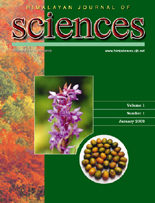Metal toxicity in plants: How do metallophytes manage to grow?
DOI:
https://doi.org/10.3126/hjs.v1i1.187Keywords:
Metal toxicity, metallophytesAbstract
Some of the metals (e.g. Cu, Mg, Mn etc.) are essential micronutrients of plants but other metals (e.g. Pb, Cr, Ni etc.) are non essential. Higher concentration of both essential and non essential metals are toxic to the plants. However, some plants called metallophytes, can grow in metal rich soil. Resistance to metal may involve exclusion from protoplast or detoxification and storage of metals in relatively inert sites such as vacuole. An understanding of genetic and physiological basis of the process involved in detoxification of metals is important in agriculture, afforestation etc. Cellular mechanisms of metal detoxification are briefly discussed. Himalayan Journal of Sciences 1(1): 51-54, 2003Downloads
Download data is not yet available.
Abstract
864
PDF
706
Downloads
How to Cite
Shrestha, B. B. (2006). Metal toxicity in plants: How do metallophytes manage to grow?. Himalayan Journal of Sciences, 1(1), 51–54. https://doi.org/10.3126/hjs.v1i1.187
Issue
Section
Articles




